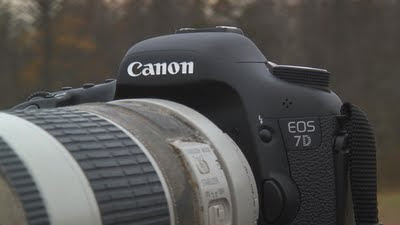After owning it for a few weeks I must say I find it much more difficult to use for filming wildlife than the Canon XL-H1. Most noticeable is that the 7D is not as effective at long range as it has a 1.6X crop factor while the XL-H1 has a 7.2X. For example the 500mmF4 has an effective focal length of 3,600mm in 35mm terms, while it is only 800mm on the 7D.
I have been working on a short film to demonstrate the video capabilities of this camera, but have not completed it yet and some want to see some samples so I am posting three clips today.
I admit that I am a poor record keeper. With still photos I depend on reading the meta-data to tell what settings I used, but as best as I can tell this function does not work with video clips. If anyone knows a way other than writing it down, please let me know.
The first clip was taken at moderate range with two different lenses. The first portion is with the 500mm F4, and the second with the 300mm F4. I cannot recall if the ISO was 100 or 200, but I am certain it was not over 200. Shutter speed was 1/60 sec. with the appropriate f stop.
 Canon 7D With 300mmF4
Canon 7D With 300mmF4 I replaced the natural sound with a sound track of crows and bluejays as there was no good natural sound at the time of the filming and the camera only recorded the thumps and bumps of me operating the tripod. (You really didn't want to hear that, did You?)
Eastern Wild Turkey Feeding-Canon 7D demo clip from Willard C. Hill on Vimeo.
The Next two clips are with the 500mm F4 at fairly close range. I prefer to use the camera on a video tripod when shooting video, but a video tripod is less than ideal for still shooting so I used the Gitzo with Wimberley head in all of the clips today. The Wimberley head actually works well if one can avoid panning and even then does fairly well with the shorter telephotos, but there is too much jerking and wiggle if one must follow motion with the 500mm.
If I recall correctly I set the ISO at 400 for this clip as it was taken late in the evening, but there was still a decent amount of light.
Whitetail Does Grooming: Canon 7D Demo Clip from Willard C. Hill on Vimeo.
I am certain that the last clip was taken at ISO 1600 and 1/60 F4. It was growing very late in the evening by this time and the light had a warm afterglow.
Whitetail Doe In Late Evening: Canon 7D Demo Clip from Willard C. Hill on Vimeo.
I look forward to exploring the video potential of this camera in more depth, but find that it is much more difficult to use for filming than the XL-H1. I previously mentioned the limited long range ability, but the LCD viewfinder is even more of a liability in bright conditions, although it works reasonably well in subdued light. It seems that one would need one of the finders such as the Zacuto Z-Finder, or IDC Viewfinder before they could realize its full potential for filming.I also have an issue with editing. I am using an older machine that handles HDV quite well with Vegas 9.0b editing software, but it crashes once I add a few of the native MOV files to the timeline. I also have Cineform Neo Scene installed on the machine and it is much more usable than the raw files, but there is still an occasional crash. The clips shown today are Cineform files, edited to remove camera movement and then rendered to Sony AVC with the Internet 16:9 HD 30P template.
In spite of some of the issues, I think the integration of HD video in DSLRs is a revolutionary change that will alter our expectations from still and video cameras alike.

